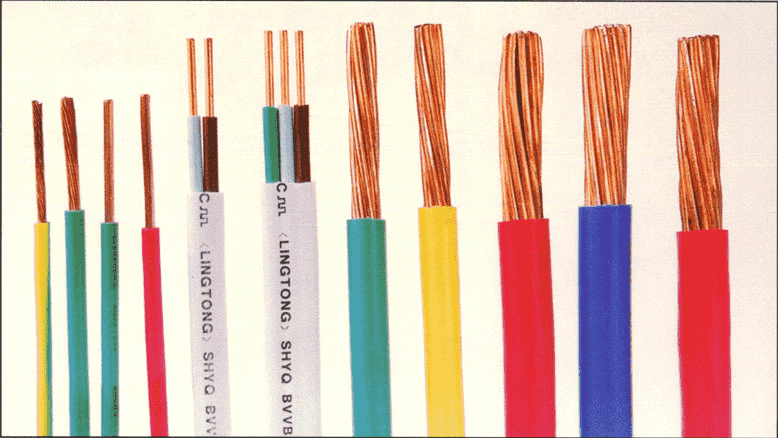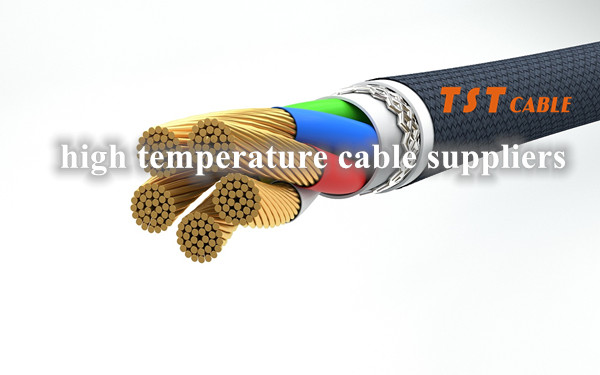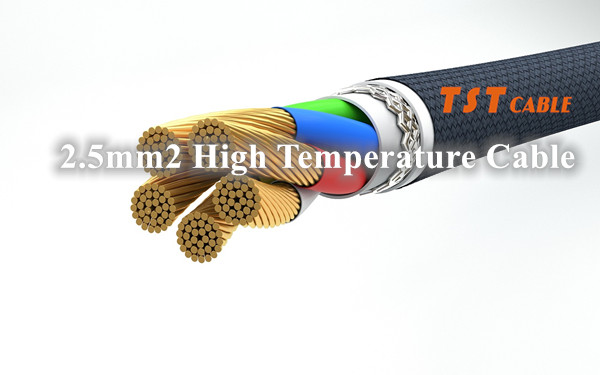
Wire and cable is a more than a hundred years old industry, the birth of a long time, the industry is mature, so there are a lot of wire and cable belonging to the industry’s terminology and special terminology, TST CABLES simple to organize a number of commonly used high temperature cable terminology, the next time you see these terms and terminology will be able to understand what the meaning of the term.
1, wire and cable – used to transmit electrical energy, information and realize the electromagnetic energy conversion wire products.
2, insulated cable – by the following parts of the aggregate: one or more insulated cores, their respective coverings (if any), the total protective layer (if any), the outer protective layer (if any), the cable can also have additional conductors without insulation.
3, soft cable – the use of the requirements of soft, and in the structure and materials to meet this (flexibility) requirements of the cable.
4, flexible cable – by more than a number of small cross-section of the conductor composed of flexible cable.
5, single core high temperature cable – only one insulated core of high-temperature cable.
6, multi core high temperature cable – more than one insulated core of the high-temperature cable
7, flat (multi-core) high-temperature cable – more than one insulated wire core group arranged in parallel into a flat multi-core high-temperature cable.
8, cable accessories – in the cable line and cable supporting the use of ancillary equipment in general.
9, bare wire – no insulation of the wire.
10, single line – a single wire.
11, stranded wire – by more than one round or type of wire in a spiral twisted into the conductor.
12, winding line – also known as electromagnetic wire, used for motors, electrical appliances and electrical instruments winding to achieve electromagnetic energy conversion wire.
13, enameled wire – with varnish insulation (layer) of the wire, mainly used as winding line.
14, high-temperature power cables – transmission and distribution of high-temperature cable.
15, non-drip cable – the impregnant does not flow in the highest continuous working temperature of the whole impregnated paper insulated cable.
16, split-phase lead sheathed cable – each insulated core extruded lead or lead alloy (sheath) sheathed three-core cable.
17, oil-filled cable – with insulating oil as a pressurized fluid, and can make the oil in the cable free flow of a self-capacitating pressure-type cable.
18, overhead insulated cable – for overhead or outdoor suspension of insulated cables.
19, communication cables – the transmission of electrical information with the cable, including municipal communications cable, long-distance communications cable, bureau cable and data communications cable.
20, stranded cable – many groups of wires arranged in concentric layers into a cable core cable.
21, unit type cable – many groups of wires to bunch or concentric stranded units, and then many units stranded into a cable core cable.
22, symmetrical cable – composed of symmetrical pairs of cables.
23, coaxial cable – by the coaxial pairs of high-temperature communication cables.
24, radio frequency cable – used as a radio transmitter and receiver antenna feeder or a variety of radio frequency communications and test equipment connection line of high temperature cable.
25, telephone cord – used as a telephone equipment connected to the soft wire.
26, conductor (wire) – cable with a specific function of conducting current components.
27, solid conductor (wire) – by a round or type of wire made of conductor (wire).
28, a single conductor – not covered with other metal layers of single or multiple metal wires of the conductor.
29, metal-plated conductor – each single wire is coated with a thin layer of a different metal or alloy conductor.
30, tin-plated conductor – tin-plated conductor.
31, metal clad conductor – by a metal as the inner part and metallurgical processing method (fusion) cladding another metal as the outer layer of the conductor.
32, concentric stranded round conductor – more than one single wire to spiral stranded, become a layer or layers of concentric layers of stranded conductors, usually adjacent layers stranded to the opposite.
33, bundle of conductors – by a number of single wire, in the same direction, the same pitch to spiral bundle and become a conductor.
34, compound stranded conductor – by several groups of wires spiral stranded into one or more layers of conductors, conductors in each group can be concentric stranded or bundled.
35, fan-shaped conductor – cross-section shape similar to the fan-shaped type conductor.
36, soft conductor – for soft cables from the diameter of the round wire small enough to form a stranded conductor.
37, tightly compressed conductor – by mechanical tightening or stretching, or appropriate selection of the shape and configuration of the single wire to reduce the stranded gap stranded conductor.
38, concentric conductor – wrapped in one or more insulated wire core outside the conductor.
39, Insulation – insulation in the cable with a specific function of withstanding voltage.
40, conductor insulation – conductor or conductor shield on the insulation.

41, extruded insulation – usually by a layer of thermoplastic or thermosetting materials extruded into the insulation.
42, winding insulation – with insulation tape spiral winding into concentric layers of insulation.
43, impregnated paper insulation – with impregnated insulating paper composed of winding insulation.
44, rubber insulation – by rubber or rubber tape composed of dense layer of insulation.
45, plastic insulation – made of plastic dense layer of insulation or tape package.
46, enameled insulation – by the enameled wire paint on the conductor formed by the continuous dense insulating film.
47, shielding – the electromagnetic field will be limited to the cable or cable components within the cable, and to protect the cable from external electric fields, magnetic fields of the shielding layer. Covered in the cable outside the shield is usually grounded.
48, conductor shielding – non-metallic or metallic materials covering the conductor of the electrical shielding layer.
49, insulation shielding – covered in insulation on the metal or non-metallic materials of the electric shielding layer.
50, insulated core – the conductor and its insulation and shielding layer (if any) of the combination.
51, the main core – wire and cable in the main function of the insulated core.
52, auxiliary core – wire and cable to assume the auxiliary function of the insulated core.
53, symmetrical pairs – by the same structure symmetrical to the longitudinal axis of the insulating core of the line composed of groups.
54, coaxial pair – by concentrically placed inside and outside the conductor (all or part of the middle with insulation support) composed of pairs.
55, filler – in the multi-core cable used to fill the gap between the various insulating cores of the material.
56, lining layer – wrapped in multi-core cable core (may include filler) outside the protective layer placed under the non-metallic layer.
57, isolation layer – used to prevent the different components of the cable between (such as conductor and insulation or insulation and sheath between) the harmful effects of the isolation of the thin layer.
58, sheath – metal or non-metallic material uniform continuous tubular cladding, usually extruded.
59,Metal sheath – a sheath made of metal.
60, wrinkled metal sleeve – with a certain corrugated shape of the metal sheath.
61, non-metallic sheath – made of polymer materials sheath.
62, combined sheath – the use of metal and plastic composite sheath.
63, outer sheath – wrapped in a metal jacket outside the non-metallic jacket as the outermost sheath of the high temperature cable.
64, armor layer – usually used to prevent the outside world mechanical impact of metal bands, wires, filaments made of high-temperature cable cover.
65, the outer layer – in the high-temperature cable outside the layer or layers of non-extruded cover layer.
66, braided layer – by the metal or non-metallic materials woven into the covering layer.
67, Percentage conductivity – at 20 ℃ international standard soft standard resistivity (IACS) and the resistivity of the material at the same temperature of the ratio, expressed as a percentage, can be calculated by weight or volume.
68, current-carrying capacity – in the allowable operating temperature of the cable conductor in the conductor of the long-term full-load current.
69, conductor cross-section – the composition of the conductor of each single line perpendicular to the conductor axis of the cross-section of the sum.
70, stranding distance – a component of the cable to spiral rotation along the axial length of a week.
71, pitch ratio – stranded elements of the stranding distance and its spiral diameter ratio.
72, stranded to – cable stranding elements relative to the cable axial direction of rotation.
73, stranding constant – the length of the element before stranding and stranding after the length of the ratio of parts.
74, fill factor – the sum of the cross-section of individual wires that make up the conductor and the conductor profile cross-section of the ratio.
75, braided coverage (braided density) – the percentage of surface area covered by braided material to the total surface area of the braided layer.
76, wire drawing – the process of drawing metal rods or wires through molds into a certain cross-section and shape of the wire.
77, annealing – continuous or discontinuous heat treatment of cold-worked metal wire to reduce or eliminate the process of cold work hardening
78, stranding – the process of manufacturing stranded conductors.
79, bundled – the process of manufacturing bundled conductors.
80, enameled – in the metal wire surface coating enameled wire lacquer process.
81, winding – with the strip around the concentric winding layer of the process.
82, overlap wrapping – strip material wrapping, strip edge and adjacent strip edge overlap each other in the form of wrapping.
83, gap wrapping – tape material wrapping, tape edge and adjacent tape edge is not lapped and leave a gap in the form of wrapping.
84, stranded – two insulated wire core according to a certain twisted pitch to form the process of line group.
85, cable – by a number of insulated wire core (or wrapped with a metal sheath core) or unit line group and other components stranded (or wrapped) into a cable core process.
86, extrusion (rubber) – will be formulated into a plastic or rubber mixture,; continuous uniform extrusion in the conductor or cable core process.
87, crosslinking – through physical or chemical methods, so that the plastic from the linear structure into a spatial network structure of the process.
88, longitudinal package – strip longitudinal wrapping process.
89, braiding – with metal wires or non-metallic fibers in the conductor or insulation layer and other components woven into the process of having a mesh pattern.
90, lead compression – the process of extruding sealed, uniform, continuous lead jacket on the cable with hot pressing method.
91, armoring – the process of wrapping an armored layer on a high temperature cable.
If you have needs or questions about high temperature cables, please feel free to email high temperature cable supplier TST CABLES and receive a free sample of high temperature cables.





